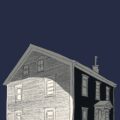This is our newsletter. Sign up here.
Victor Luckerson is a Tulsa journalist and the author of “Built from the Fire,” which was released this week by Penguin Random House. It tells the story of Tulsa’s Greenwood District, also known as Black Wall Street, and the Tulsa Race Massacre through the experiences of the Goodwins, a family who helped rebuild the neighborhood.
I spoke with Luckerson about writing “Built from the Fire,” moving to Tulsa and how gentrification can impact neighborhoods like Greenwood. Our conversation has been edited for clarity and length.
Mollie Bryant: You’ve talked about getting past the mythology of Black Wall Street, and I wondered if you think Black Wall Street, just that name, is part of the mythology.
Luckerson: Yeah, it is in a few different ways. There is a passed-down narrative that Booker T. Washington visited Greenwood and christened it Black Wall Street in the 1910s, but in my research, I could never find any evidence that he actually did that. So even starting there, there’s sort of a mythology that was passed down that is hard to pin down with evidence.
The actual first example of anything like that phrase I could find was actually by a woman, Mary E. Jones Parrish. She was a Greenwood resident who survived the massacre and wrote the first book about what happened and the events of the disaster. In that book, she calls Greenwood “the negro’s Wall Street.” That’s an early example of a mythology emerging around this place.
I’ve talked to folks who grew up in poverty in mid-century Greenwood, and some of them don’t identify with that phrase, Black Wall Street. For them, wealth was not the center of their perception of what this place was. Talking to folks like that who lived here in that era and don’t identify with the term, as well as what I found in my research about the origins of it made it important for me to draw a distinction. The place is both Greenwood and Black Wall Street, but it’s functioning on different planes when you say those two phrases.
Bryant: Why was it important for you to get past the mythology of this place? How did you go about that as you were writing?
Luckerson: Puncturing that mythology happened during my process. I did not come into writing this book with the intention of doing that. I learned about Greenwood as this Black utopia and this mecca of wealth, and my thought process initially was that I was going to be able to sort of explain how they did it and give us lessons for today about how to recreate it.
When I first started doing the research, I was living in Atlanta, and every day before my full-time job, I would read the Tulsa Star from 1910s Greenwood to learn what the place was like. I was seeing all these articles that were like, “We don’t have paved streets, we don’t have streetlights. We need all this support that the city of Tulsa is not providing.” I realized that Greenwood had a lot of successful entrepreneurs that had a lot of solidarity and community, but it also was being deprived of utilities and resources by the city of Tulsa, and so I thought it was important to illustrate that this place wasn’t a snow globe. It was being buffeted by the policies implemented by the city, by the state, by the country, both before the massacre and at every step since then.
Bryant: One of the things your book is doing is telling a multigenerational story, which I love as a narrative technique. My husband recently read a novel (“Daughters of the New Year” by E.M. Tran) that had an intergenerational story and he said it was like time didn’t exist, that all of the family members’ stories could exist at the same time in that book, and I really like that thought. Why did using that type of narrative feel right for you?
Luckerson: I think it’s interesting what your husband said about time not existing because one of my huge influences and all-time favorite books is “One Hundred Years of Solitude” by Gabriel García Márquez. That book is about the epitome of that dynamic of time flowing forwards and backwards. That was one of my inspirations.
I had a non-fiction inspiration, which was “The Warmth of Other Suns” by Isabel Wilkerson, which is not necessarily intergenerational, but it does follow individual people over the course of their entire lives, and so it is generational in the sense we watch the eras of America change over time.
The family at the center of the book, the Goodwins, when you go to Greenwood today, if you stand there at the corner of Greenwood and Archer Street, you’re going to see The Oklahoma Eagle office. It’s kind of an old auto garage, which has a newspaper office in it, and that’s the only land owned by an individual Black family in that core part of Greenwood.
The fact they’ve survived that long in this space and that they had so many different roles in the community was also really important to me. Following this family across four generations, I found that they were the main street business owner, they were the newspaper publisher, the journalist, the activist, the legislator, the educator, the attorney, even the hustler. There’s a whole chapter in the book about gambling in Greenwood and the role the family played in that. I think they were a great family to follow, not only through the generations of what happened in Greenwood, but also to exemplify all the different types of people you need to make a community thrive.
Bryant: I was really interested in your move to Tulsa to write this. You’re originally from the south, and I’m curious if living in Tulsa has given you a chance to connect to that part of yourself, or maybe more specifically connect to the Black southern experience. You’ve mentioned when you first moved to Oklahoma, you got really into Charley Pride. I was wondering if there was anything else like that, like listening to Charley Pride, that helped you connect to that stuff?
Luckerson: I have a Black country playlist that I play on all of my road trips in Oklahoma. When I travel to the Capitol to do reporting, I’m always playing this ever-expanding, Black country playlist. That’s on the lighter side of it.
Certainly on the more challenging side, just being in the space of Greenwood helped me write the book in a way that I hope can connect with people. I actually wrote three chapters in the book about the race massacre itself right around the centennial. To write those chapters, I went up to Standpipe Hill, which is a location in Greenwood where a machine gun was placed by the National Guard and fired down upon the neighborhood. I wrote them by hand in a moleskin notebook, which, I don’t really do that kind of thing anymore, but I did for that, and it really helped me.
I think being in that space, writing by hand, helped me elevate that part of the book beyond journalism or academic research and certainly felt more real and connected to the past, so I think there were a lot of ways that being here in the space and being in Oklahoma really transformed the way that I approached the project.
Bryant: Anything else you think folks should know?
Luckerson: I think it’s important for people to understand that Greenwood underwent a second destruction in the 1960s and 70s due to urban renewal and highway construction. It was really important for me in what I wrote to walk through the mechanics of how that happened because it happened in communities all across America. That’s hopefully a valuable addition to the scholarship and narrative about this place and something I think anyone who lives in any city in America is going to find some echoes of in their community.
Go deeper:
- Learn more about “Built from the Fire”
- Listen to Luckerson’s Black country playlist
- Read The Oklahoma Eagle
- Read centennial coverage of the Tulsa Race Massacre from Tulsa World and The Oklahoman
New from Streetlight
- How rental assistance programs have evolved since the pandemic: Before the pandemic, just a few dozen communities offered rental assistance or eviction prevention programs. Now that number is closer to 180, according to the Treasury Department. These programs are facing steady demand for their services, and some are dealing with questions of how to remain a long-term resource for their communities.
- ICYMI: Criminal records can lock people out of housing assistance. HUD’s creating new rules to help.
Thank you for reading our newsletter. Send feedback, tips and your best lasagna recipe to me at bryant@streetlightnews.org and 405-990-0988.
– Mollie Bryant
Founder and editor, Streetlight



